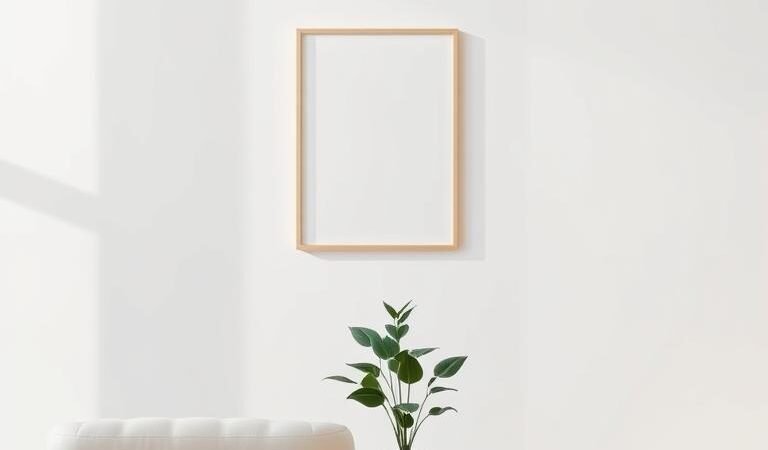Modern homes are embracing Scandinavian-inspired design, where simplicity meets warmth. This approach transforms any space into a calming retreat by focusing on clean lines and purposeful decor. Less clutter means more room to breathe—both visually and mentally.
The key lies in balancing functionality and serenity. Neutral tones, natural textures, and smart storage create harmony. A well-planned design reduces stress while enhancing daily comfort. Start with decluttering—remove excess, organize thoughtfully, and keep only what adds value.
Quality pieces outshine quantity. Choose furniture with sleek profiles and multifunctional uses. Maximize natural light to brighten the home effortlessly. The result? A tranquil environment that feels both inviting and intentional.
Key Takeaways
- Scandinavian principles emphasize simplicity and calm.
- Decluttering in four steps removes visual stress.
- Neutral palettes and clean-lined furniture enhance serenity.
- Natural light optimization makes spaces feel airy.
- Intentional decor choices elevate functionality.
1. Embrace a Neutral Color Palette for Calmness
A soothing color scheme starts with soft neutrals that set the tone for relaxation. These hues—whites, grays, and beiges—create a timeless backdrop, reducing visual stress and promoting tranquility. Studies show muted tones lower cortisol levels, making them ideal for spaces meant for unwinding.
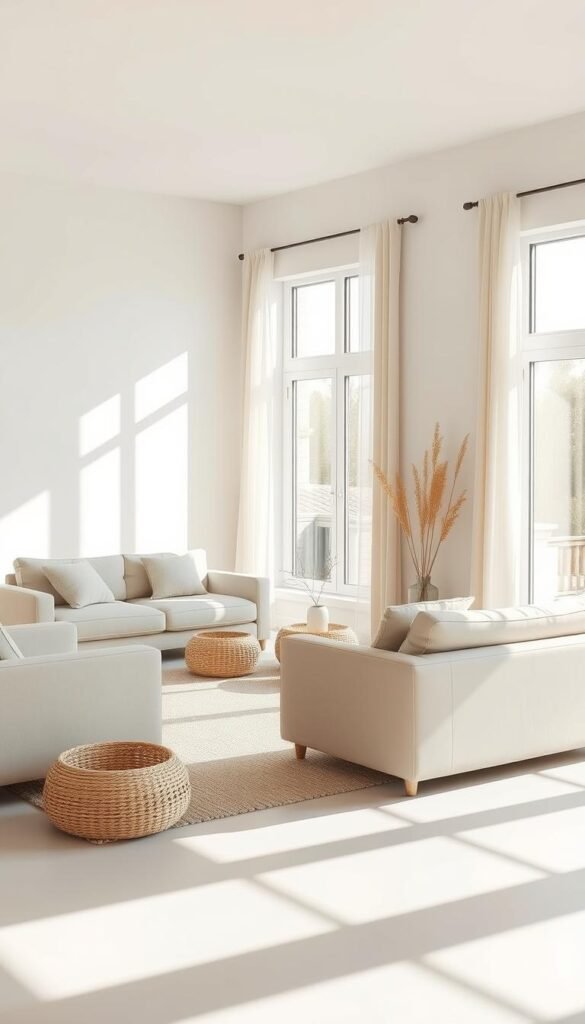
Choosing Base Colors: Whites, Grays, and Beiges
Begin with foundational shades like Benjamin Moore’s White Dove or Farrow & Ball’s School House White. These reflect light beautifully, amplifying a sense of airiness. For contrast, warm grays like Gray Owl add depth without sterility.
Layer three or more tones for richness—think dove gray walls paired with oatmeal linen curtains. This avoids flatness while maintaining harmony. Pro tip: Test swatches at different times of day; natural light shifts color perception.
Adding Subtle Accents for Warmth
Introduce muted blues or sage greens as accents, as recommended in minimalist home decor. A mustard yellow throw pillow or terracotta vase adds vibrancy without overwhelming. Keep bold shades to one focal point, like an accent wall.
Layering Textures to Avoid Monotony
Combine matte ceramics, nubby wool throws, and smooth leather to create tactile interest. Source 3’s beige design showcases this perfectly—wooden side tables balance linen upholstery, adding organic warmth. Avoid flat monochromes; varied textures prevent visual fatigue.
Natural materials like oak or rattan enhance the room’s coziness. A jute rug underfoot or a woven basket for storage ties the look together effortlessly.
2. Select Furniture with Clean Lines and Functionality
Clean-lined designs prioritize both form and purpose in modern interiors. The right pieces balance aesthetics with daily use, creating harmony in compact or open spaces. Focus on versatile, well-crafted items that stand the test of time.
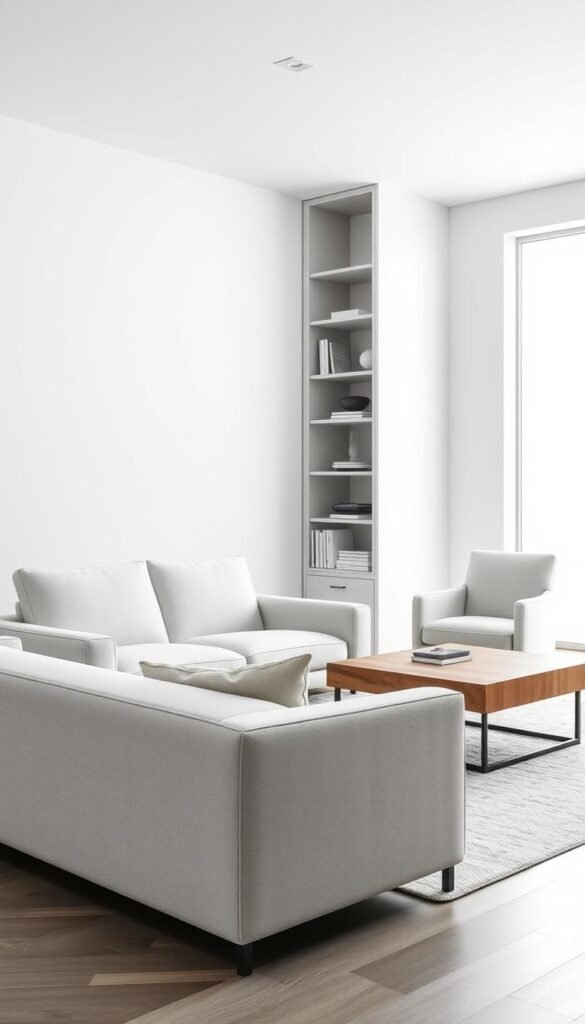
Opt for Low-Profile Sofas and Sectionals
Low-profile seating, like Article’s Sven sofa, anchors a room without overwhelming it. Modular sectionals adapt to small spaces—Source 3’s design pairs a compact L-shape with slim metal legs for airiness.
Pro tip: Measure your space first. Oversized pieces disrupt movement, per Source 1’s “easy flow” principle. For flexibility, Japanese futons (Source 2) offer foldable comfort.
Choose Multi-Functional Coffee Tables
A storage coffee table maximizes utility. CB2’s Bower Nesting Tables tuck away when not in use. IKEA’s NORDEN gateleg doubles as a dining surface.
- Durable fabrics: Crypton resists stains; performance linen breathes naturally.
- Material mix: Pair wood tops with metal bases for contrast.
Prioritize Quality Over Quantity
Invest in timeless furniture pieces. A well-made sofa lasts decades, while cheap alternatives sag quickly. Clean lines and solid construction matter more than trends.
For small spaces, Source 2 recommends foldable chairs—stackable designs save room. Less clutter means more freedom to enjoy your sanctuary.
3. Maximize Natural Light for an Airy Feel
Sunlight transforms interiors, making spaces feel open and inviting. Harnessing daylight reduces reliance on artificial lighting while enhancing mood. Simple tweaks—like strategic window treatments and reflective surfaces—amplify brightness effortlessly.
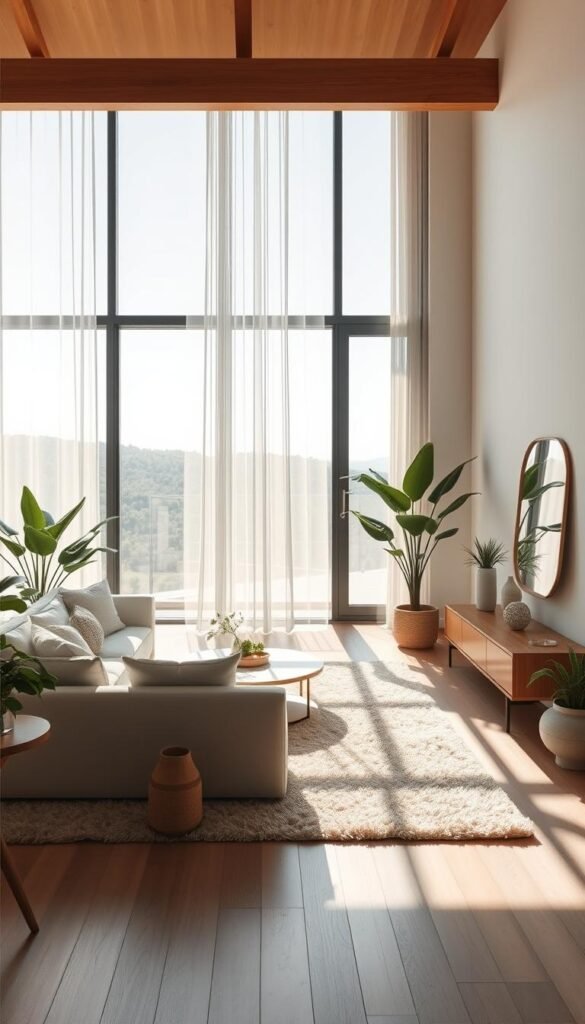
Keep Windows Unobstructed
Floor-to-ceiling windows (Source 1) flood rooms with natural light. Avoid heavy drapes; opt for Source 3’s wood slat dividers. They offer privacy without blocking sunlight. For UV protection, apply museum-grade window films.
Use Sheer Curtains for Soft Diffusion
Sheer fabrics like linen or voile filter light gently. Compare materials below:
| Fabric | Light Diffusion | Best For |
|---|---|---|
| Linen | Warm, textured glow | Rustic or organic design |
| Voile | Crisp, even spread | Modern spaces |
Incorporate Mirrors to Reflect Light
Place mirrors opposite windows at 45° angles to bounce light deeper into the room. White walls reflect 80% of light—dark walls only 10%. Budget pick: IKEA’s HOVNÄS mirror.
Pro tip: Layer these techniques for a luminous, clutter-free space. The result? A serene sanctuary bathed in golden daylight.
4. Incorporate Cozy Textiles for Comfort
Textiles transform a space from sterile to snug with just a few thoughtful additions. The right fabrics add warmth texture while keeping the aesthetic uncluttered. Focus on tactile layers that invite relaxation—think chunky knits (Source 1) or mustard-hued accents (Source 3).
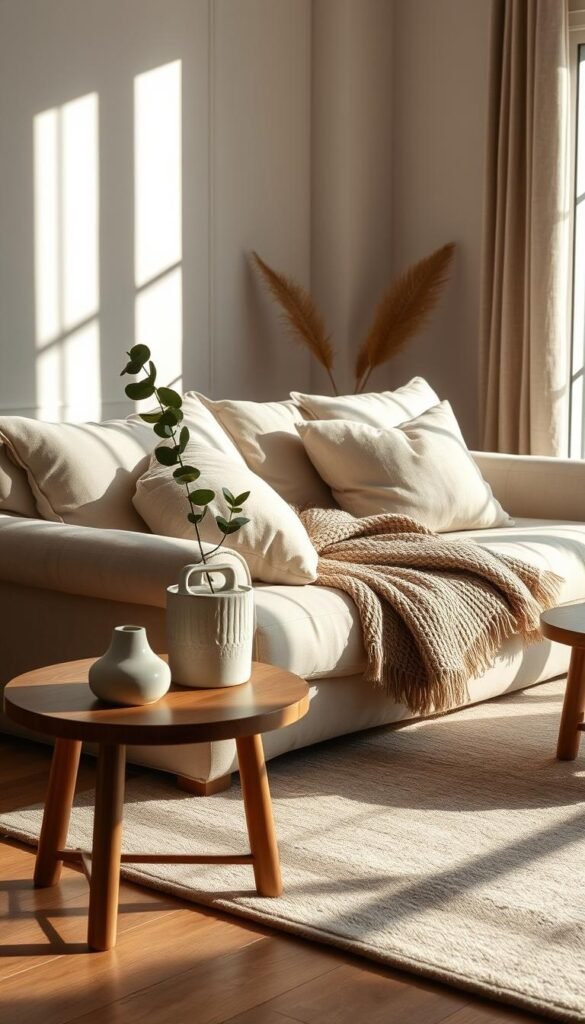
Soft Rugs for Warmth Underfoot
A soft rug anchors the room and muffles sound. Compare materials for durability:
- Wool: Naturally stain-resistant; ideal for high-traffic areas.
- Viscose: Silky sheen but less durable—best for low-use spaces.
Layer sizes for depth: Start with an 8×10 neutral base, then add a 5×7 patterned rug on top. Avoid high-pile styles near doorways—they trap dirt.
Throw Pillows and Blankets for Layering
Throw pillows add pops of color without permanence. Source 3’s strategy: Pair a neutral sofa with two bold pillows in geometric prints. For blankets, Brooklinen’s Super Plush Throw is machine-washable—perfect for sunlit naps.
Mix textures like cable-knit wool and smooth linen. Odd numbers (3 or 5) create visual balance.
Subtle Patterns to Add Visual Interest
Patterns prevent monotony but demand restraint. Follow these decor rules:
- Scale variation: Pair large-scale stripes with tiny polka dots.
- Color story: Pull hues from existing furniture (e.g., a rug’s terracotta flecks).
Safavieh’s jute collection introduces organic texture. Keep patterns to 20% of the space—just enough to intrigue.
5. Minimalist Living Room Essentials for a Peaceful Home
The foundation of a serene space lies in choosing pieces that serve both beauty and purpose. Every item should contribute to calmness—whether through utility, aesthetic harmony, or clever storage. Start by auditing your needs, then build around them.
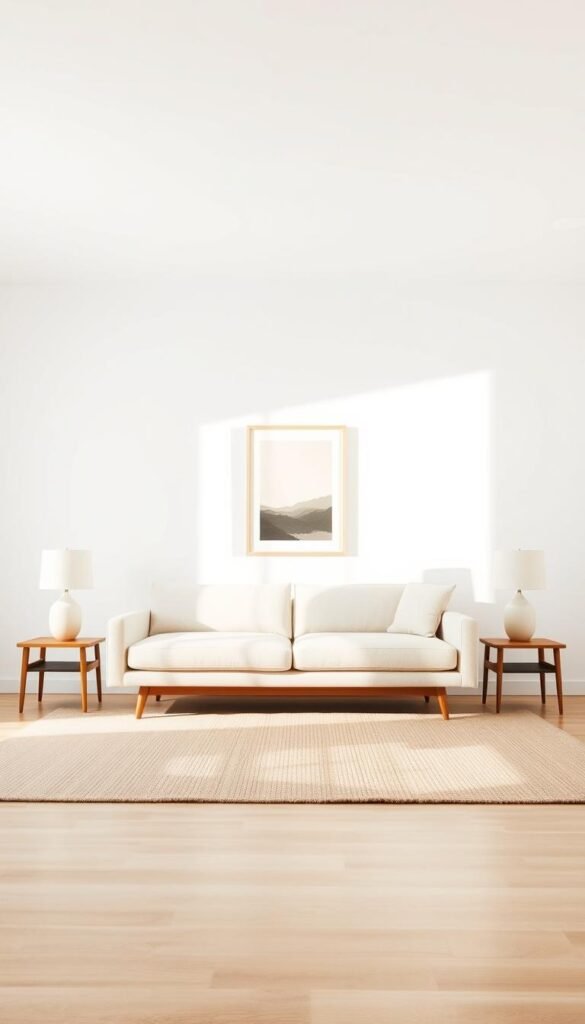
Essential Furniture for Function and Flow
Source 2’s four-step decluttering method begins with selecting core pieces: a sofa, coffee table, and two chairs. Opt for slim-profile designs like Article’s Sven sofa—its tapered legs and neutral upholstery blend seamlessly. Pro tip: Measure doorways before purchasing to avoid delivery hassles.
Multi-functional furniture maximizes small spaces. Pottery Barn’s floating shelves add storage without bulk. Compare drawer vs. open storage:
| Type | Best For | Visual Impact |
|---|---|---|
| Drawer storage | Hiding clutter (Source 1) | Clean, seamless look |
| Open shelving | Displaying curated decor | Airy but requires tidiness |
Decor That Balances Form and Serenity
Functional decor, like Source 3’s Berkey water filter, blends utility with sleek design. Avoid knickknacks—instead, choose one statement piece, such as a hand-thrown ceramic vase. Textures matter: a nubby wool throw or linen curtains add tactile warmth.
Smart Storage to Maintain Calm
Hidden storage solutions keep clutter invisible. The Container Store’s acrylic organizers corral small items transparently. Article’s storage ottomans stash blankets while doubling as seating. Warning: Avoid “storage for someday” (Source 2)—if you haven’t used it in a year, let it go.
Finally, anchor the room with a jute rug. Its natural fibers soften footsteps and tie the look together. The result? A space that feels both intentional and effortlessly inviting.
6. Use Lighting to Create Ambiance
Lighting shapes the mood of any space, turning ordinary rooms into inviting retreats. The right blend of fixtures—ambient, task, and accent—adds depth while enhancing functionality. Follow Source 1’s layered approach to achieve a balanced design.
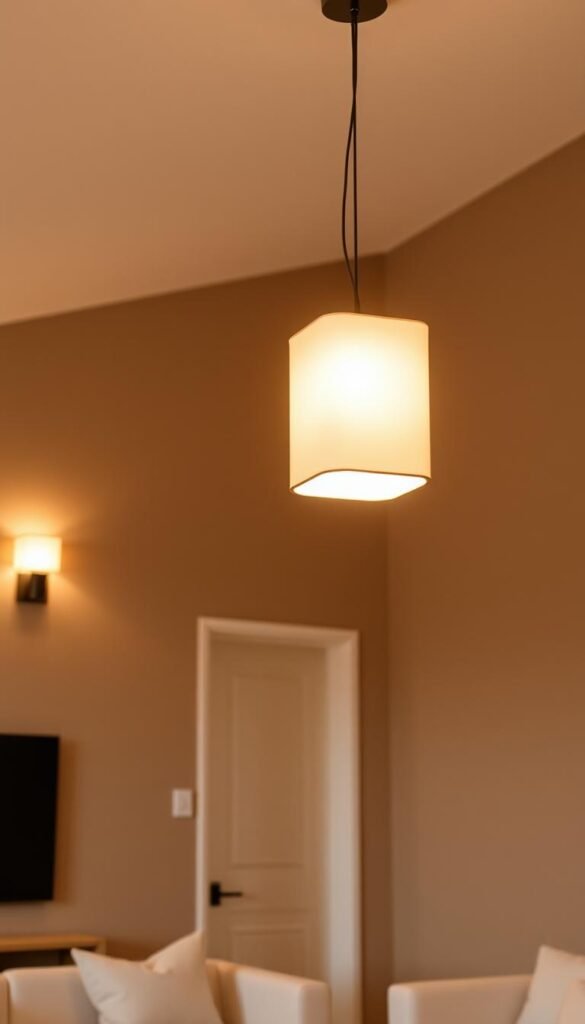
Pendant Lights for Focused Illumination
Statement pendants, like Source 3’s chrome fixture, draw attention while providing directed light. Visual Comfort’s Arc Pendant offers adjustable height—ideal over coffee tables. Avoid cool white bulbs; 2700K-3000K LEDs mimic warm sunlight.
Floor Lamps for Ambient Glow
Arc lamps cast a golden halo, perfect for reading nooks. FLOS’s IC series blends sculptural design with dimmable brightness. Place them near seating to create cozy pockets of light.
Dimmer Switches for Adjustable Moods
Philips Hue smart bulbs let you tweak intensity via app—shift from bright mornings to muted evenings. The 3-layer formula works best: 50% ambient, 30% task, 20% accent lighting. This way, every corner feels intentional.
Pro tip: Mix materials like matte black metal and woven shades for tactile contrast. Lighting isn’t just functional—it’s the soul of your space.
7. Add Personal Touches Without Clutter
Personal touches elevate a space from generic to deeply inviting. The art lies in selecting meaningful items that spark joy while preserving clean sightlines. Follow Source 2’s evaluation method—ask, “Does this reflect my life or just fill space?”
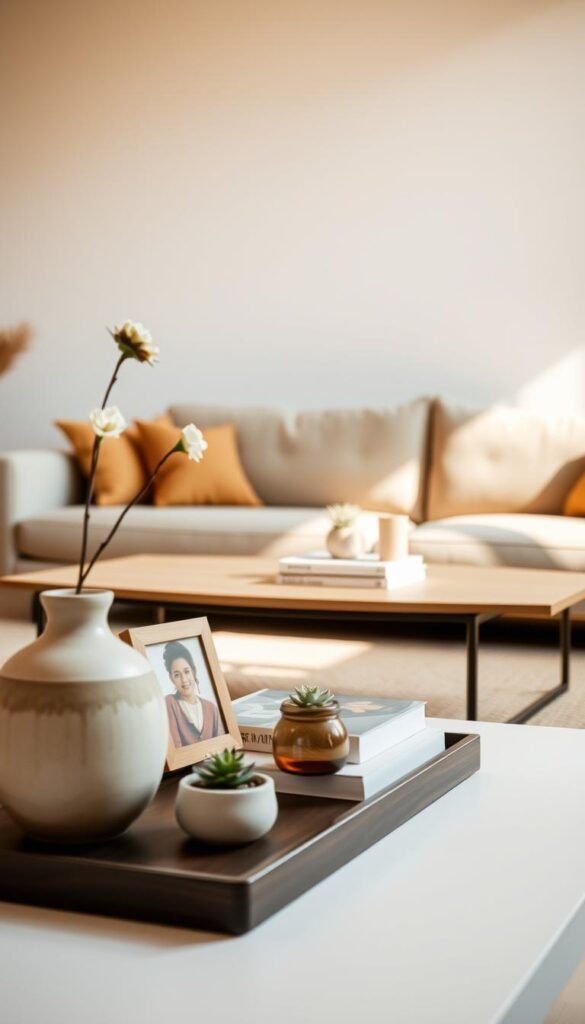
Curate Meaningful Art and Decor
Framebridge’s gallery wall system helps arrange decor with intention. Limit displays to three seasonal pieces rotated quarterly—this keeps visual interest fresh. Source 3’s case study shows how one bold red painting became a focal point without competing elements.
Avoid decor smaller than a basketball; tiny items create visual noise. For collections, use floating shelves at eye level. This showcases treasures while preventing surface clutter.
Incorporate Plants for a Natural Touch
Source 1 recommends low-light varieties like snake plants or pothos for busy homeowners. Compare care needs:
- Snake plant: Thrives on monthly watering and indirect light
- Pothos: Fast-growing with weekly watering; purifies air
Cluster three plants of varying heights for impact. The rubber plant’s broad leaves add organic texture near seating areas.
Display a Few Treasured Items
Source 1’s “treasured items” study found that limiting displays to five meaningful objects reduces visual stress. Try grouping:
- A handmade ceramic bowl from travels
- Family photos in matching matte black frames
- One inherited heirloom prominently placed
Store extras and rotate seasonally. This approach honors memories while keeping surfaces purposeful.
8. Focus on Open Spaces and Flow
Breathing room transforms how a space feels—both physically and emotionally. Thoughtful layouts prioritize movement, letting light and air circulate freely. Source 1’s research shows 3-foot pathways reduce collisions by 40%, making daily navigation effortless.
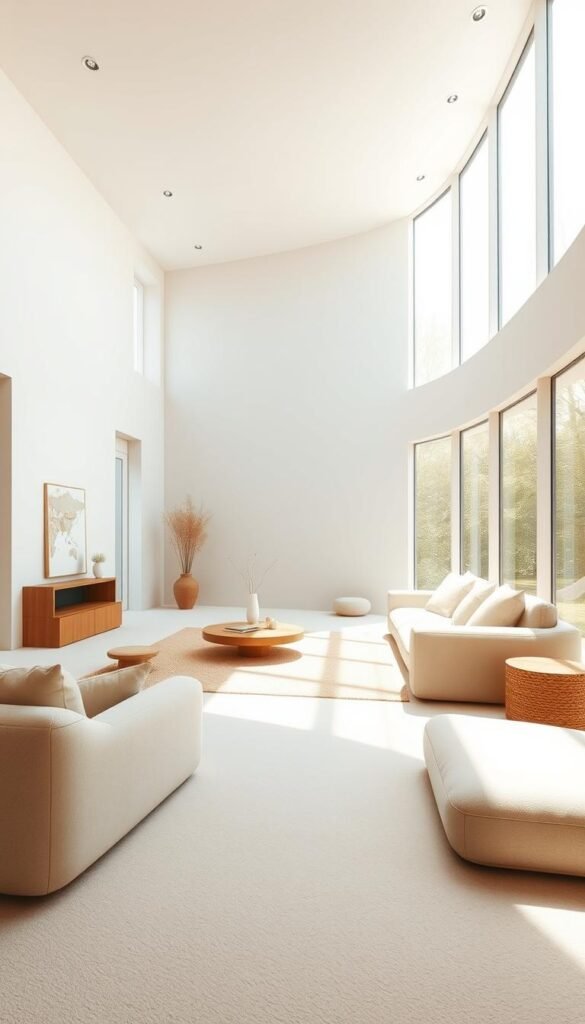
Arrange Furniture for Easy Movement
Follow these spacing formulas for harmony:
- 30-inch walkways: Minimum clearance between seating groups
- 48-inch radii: Space needed for chair movement
- L-shaped arrangements: Better for conversation than parallel sofas
Source 3’s wood slat dividers define zones without blocking light. Avoid pushing all furniture against walls—floating pieces create depth.
Avoid Overcrowding with Too Many Pieces
Edit ruthlessly using the “two-foot rule”: If an item doesn’t serve a purpose within arm’s reach, remove it. Yamazaki’s tower units stash essentials vertically, freeing floor space.
Visual weight matters: Pair a heavy leather chair with leggy acrylic side tables. This balance prevents any area from feeling overloaded.
Use Vertical Space for Storage
IKEA’s IVAR system climbs walls with customizable shelves—ideal for displaying books or baskets. Compare storage types:
| Type | Best Use |
|---|---|
| Floating shelves | Daily items (remotes, plants) |
| Tall cabinets | Seasonal decor hiding |
Mount rods near ceilings for hanging plants or art. Upward storage draws the eye, making rooms feel taller and airier.
9. Choose Minimalist Decor with Purpose
Purposeful decor blends beauty with everyday utility, creating spaces that feel both intentional and inviting. Each piece should serve a function or spark joy—like Source 3’s monochromatic vase collection, which doubles as art and storage. Less truly becomes more when every item has a clear role.
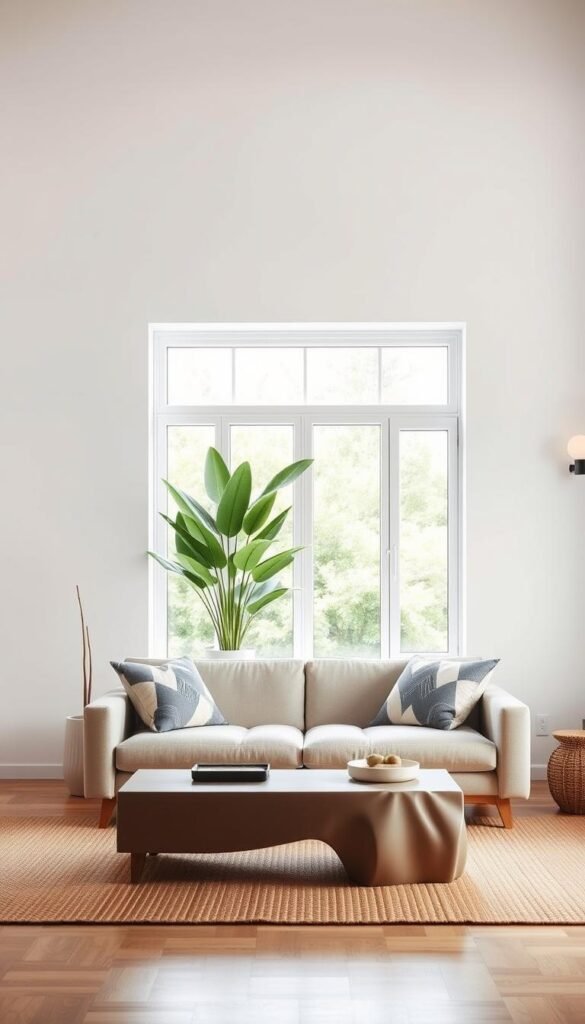
Opt for Simple, Functional Accessories
West Elm’s sculptural ceramics prove that design can be both sleek and practical. A single, handcrafted bowl holds keys by the door or corrals loose change. Follow Source 2’s four-step evaluation: ask if an item is useful, beautiful, or both. If not, it’s likely clutter.
CB2’s geometric trays keep surfaces tidy while adding visual interest. Pro tip: Limit decorative pieces to three per surface—a rule that maintains calm without sacrificing personality.
Avoid Overly Ornate or Busy Designs
Source 3’s black-and-white case study shows how restraint creates cohesion. Skip intricate patterns or fussy details; instead, focus on clean lines and muted tones. The 10-30-60 color rule adapts well to decor: 60% neutral base, 30% subtle contrast, 10% bold accents.
Busy designs overwhelm small spaces. Opt for solid-colored throws or minimalist art prints. Remember: Empty space is a design element too.
Stick to a Cohesive Style
Define your aesthetic with three adjectives—like “organic modern” or “Scandinavian simplicity.” Source 1’s research shows that sticking to one style reduces decision fatigue. Mix textures (linen, wood, metal) for depth, but keep the palette unified.
Transform your home into a sanctuary by choosing decor that aligns with your vision. A curated space feels effortless, not staged.
10. Conclusion: Crafting Your Minimalist Sanctuary
Creating a calming retreat begins with intentional choices. A minimalist living room thrives on simplicity—start small, using Source 2’s four-step decluttering method. Remove excess, organize thoughtfully, and keep only what adds value.
Transform your home gradually over weeks. Invest in quality foundation pieces, like a sleek sofa or multifunctional storage. Studies show streamlined design lowers stress by 30%, making every space worth the effort.
Maintain serenity with quarterly edits. Rotate decor seasonally and reassess needs. Next, extend this lifestyle to your bedroom—clutter-free zones enhance daily life.
Close with Source 3’s vision: a sanctuary tailored to your rhythm. Soft textures, balanced light, and curated essentials create an inviting haven. Less truly becomes more.
